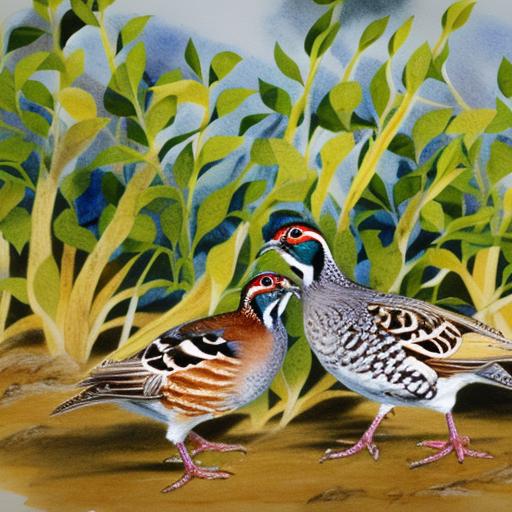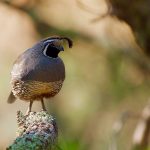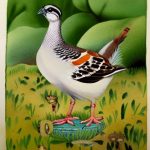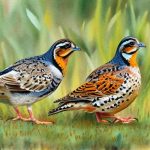Quails are small, ground-dwelling birds that belong to the family Phasianidae. They are known for their delicious meat and eggs, making them popular among farmers and hobbyists alike. In Australia, there are several native quail species that have been domesticated for agricultural purposes. These Australian quail breeds are prized for their hardiness, adaptability, and flavorful meat. They are also valued for their ability to thrive in a variety of climates and environments, making them an ideal choice for small-scale poultry farming.
Australian quail breeds have a rich history that dates back to the early days of European settlement in the country. Quails were originally brought to Australia from Europe and Asia, where they were raised for their meat and eggs. Over time, these imported quails adapted to the Australian environment and developed unique traits and characteristics that set them apart from their European and Asian counterparts. Today, Australian quail breeds are highly sought after for their superior meat quality, high egg production, and ease of care. Whether you are a seasoned poultry farmer or a beginner looking to start a small quail farm, Australian quail breeds are an excellent choice for anyone looking to raise these delightful birds.
Key Takeaways
- Australian quail breeds are diverse and unique, with a rich history and cultural significance in Australia.
- Australian quail breeds are known for their small size, colorful plumage, and distinctive calls, making them popular among bird enthusiasts.
- Some popular Australian quail breeds include the King Quail, Brown Quail, and Stubble Quail, each with its own unique characteristics and traits.
- Breeding and rearing Australian quail requires careful attention to diet, nesting, and incubation conditions to ensure healthy offspring.
- Proper housing and care for Australian quail includes providing a suitable enclosure, access to fresh water, and a balanced diet to support their health and well-being.
Characteristics and Physical Traits of Australian Quail Breeds
Australian quail breeds are known for their small size, plump bodies, and distinctive plumage. They typically have mottled brown or gray feathers that provide excellent camouflage in their natural habitat. Their round bodies and short legs make them well-suited for ground-dwelling activities such as foraging for food and nesting. Australian quails also have a unique call that is often described as a series of short, sharp whistles, making them easily recognizable in the wild.
In addition to their physical traits, Australian quail breeds are also known for their hardiness and adaptability. They are able to thrive in a variety of climates and environments, making them an ideal choice for farmers and hobbyists in different regions of Australia. Australian quails are also known for their high egg production, with some breeds laying up to 300 eggs per year. This makes them a valuable addition to any small-scale poultry operation. Overall, Australian quail breeds are prized for their unique physical traits, adaptability, and high productivity, making them an excellent choice for anyone looking to raise quails for meat and eggs.
Popular Australian Quail Breeds
There are several popular Australian quail breeds that are favored by farmers and hobbyists for their meat and egg production. One of the most popular breeds is the King Quail, also known as the Chinese Painted Quail. This breed is prized for its striking plumage, small size, and high egg production. King Quails are also known for their gentle disposition, making them an excellent choice for beginners or families with children. Another popular Australian quail breed is the Brown Quail, which is native to Australia and New Guinea. This breed is valued for its delicious meat and hardiness, making it a popular choice for commercial quail farming.
The Coturnix Quail is another popular breed that is widely raised for its meat and eggs. This breed is known for its rapid growth rate, high egg production, and mild temperament, making it a favorite among commercial quail farmers. The Coturnix Quail also comes in a variety of color mutations, including tuxedo, silver, and golden, making it a visually appealing addition to any quail farm. Overall, these popular Australian quail breeds are prized for their meat and egg production, adaptability, and unique physical traits, making them an excellent choice for anyone looking to raise quails for agricultural purposes.
Breeding and Rearing Australian Quail
Breeding and rearing Australian quail requires careful planning and attention to detail in order to ensure the health and productivity of the birds. When breeding Australian quail, it is important to provide a suitable environment that mimics their natural habitat. This includes providing ample space for nesting and foraging, as well as access to clean water and high-quality feed. It is also important to carefully select breeding stock with desirable traits such as high egg production, rapid growth rate, and good temperament.
When rearing Australian quail chicks, it is important to provide a warm and secure environment to promote healthy growth and development. Chicks should be kept in a brooder with a heat source to maintain the appropriate temperature, as well as access to clean water and chick starter feed. It is also important to monitor the chicks closely for any signs of illness or distress, and to provide appropriate veterinary care as needed. As the chicks grow, they can be transitioned to larger housing with access to outdoor space for exercise and foraging.
Overall, breeding and rearing Australian quail requires careful attention to the birds’ needs and behaviors in order to ensure their health and productivity. By providing a suitable environment, selecting breeding stock with desirable traits, and closely monitoring the chicks’ growth and development, farmers and hobbyists can successfully raise Australian quail for meat and eggs.
Housing and Care for Australian Quail
Housing and care for Australian quail is essential for ensuring the health and well-being of the birds. When housing Australian quail, it is important to provide a suitable environment that meets their specific needs. This includes providing ample space for nesting, roosting, and foraging, as well as protection from predators and inclement weather. Quails should be housed in well-ventilated coops or aviaries with clean bedding material such as straw or wood shavings.
In addition to suitable housing, care for Australian quail also includes providing high-quality feed and clean water on a regular basis. Quails should be fed a balanced diet that meets their nutritional needs, including a mix of commercial quail feed, grains, greens, and protein sources such as mealworms or crickets. It is also important to provide access to grit or small stones to aid in digestion.
Care for Australian quail also includes monitoring the birds closely for any signs of illness or distress, such as changes in behavior or appetite. It is important to provide appropriate veterinary care as needed to ensure the health of the birds. By providing suitable housing, high-quality feed, clean water, and attentive care, farmers and hobbyists can ensure the health and well-being of their Australian quail.
Health and Nutrition for Australian Quail

Health and nutrition are essential aspects of raising Australian quail for meat and eggs. Providing a balanced diet that meets the nutritional needs of the birds is crucial for promoting healthy growth and productivity. Quails should be fed a mix of commercial quail feed, grains such as millet or sorghum, greens such as spinach or kale, and protein sources such as mealworms or crickets. It is also important to provide access to grit or small stones to aid in digestion.
In addition to providing a balanced diet, it is important to monitor the health of Australian quail closely for any signs of illness or distress. Common health issues in quails include respiratory infections, parasites, and injuries from pecking or fighting. It is important to provide appropriate veterinary care as needed to address any health concerns and prevent the spread of illness within the flock.
Overall, providing a balanced diet that meets the nutritional needs of Australian quail, monitoring their health closely, and providing appropriate veterinary care as needed are essential aspects of ensuring the health and productivity of the birds.
Conservation and Preservation Efforts for Australian Quail Breeds
Conservation and preservation efforts are essential for protecting the genetic diversity of Australian quail breeds and ensuring their long-term survival. As with many domesticated animal species, Australian quail breeds face threats such as habitat loss, predation, disease, and genetic erosion. Conservation efforts aim to protect these valuable breeds by preserving their genetic diversity through breeding programs, establishing protected habitats, and promoting sustainable farming practices.
One important aspect of conservation efforts for Australian quail breeds is maintaining genetic diversity within the captive population. This can be achieved through careful breeding programs that aim to preserve desirable traits such as high egg production, rapid growth rate, and good temperament. By maintaining genetic diversity within the captive population, farmers and hobbyists can help ensure the long-term survival of these valuable breeds.
Another important aspect of conservation efforts for Australian quail breeds is promoting sustainable farming practices that minimize the impact on natural habitats. This includes providing suitable housing and care for quails that mimics their natural environment, as well as implementing practices that reduce waste and conserve resources.
Overall, conservation and preservation efforts are essential for protecting the genetic diversity of Australian quail breeds and ensuring their long-term survival. By maintaining genetic diversity within the captive population through careful breeding programs and promoting sustainable farming practices that minimize impact on natural habitats, farmers and hobbyists can play a crucial role in protecting these valuable breeds for future generations.
If you’re interested in learning more about Australian quail breeds, you might also want to check out an informative article on what vegetables quails eat on PoultryWizard’s website. This article provides valuable insights into the dietary preferences of quails and can help you ensure that your quails are getting the nutrition they need. You can find the article here.
FAQs
What are some common Australian quail breeds?
Some common Australian quail breeds include the King Quail (also known as the Chinese Painted Quail), the Brown Quail, and the Stubble Quail.
What are the characteristics of Australian quail breeds?
Australian quail breeds are generally small in size, with colorful plumage and distinctive markings. They are known for their quick movements and ability to fly short distances.
What type of environment do Australian quail breeds thrive in?
Australian quail breeds thrive in a variety of environments, including grasslands, woodlands, and agricultural areas. They prefer areas with dense vegetation for cover and protection.
What do Australian quail breeds eat?
Australian quail breeds are omnivorous and feed on a diet of seeds, insects, and small invertebrates. They are also known to consume grasses and other plant matter.
Are Australian quail breeds suitable for backyard or domestic settings?
Yes, Australian quail breeds are often kept in backyard or domestic settings for their attractive appearance and pleasant calls. They are relatively easy to care for and can be kept in aviaries or enclosures.
Are Australian quail breeds protected or regulated in any way?
Some Australian quail breeds, such as the Brown Quail, are protected under wildlife conservation laws in certain states. It is important to check local regulations before keeping or breeding Australian quail breeds.
Meet Walter, the feathered-friend fanatic of Florida! Nestled in the sunshine state, Walter struts through life with his feathered companions, clucking his way to happiness. With a coop that’s fancier than a five-star hotel, he’s the Don Juan of the chicken world. When he’s not teaching his hens to do the cha-cha, you’ll find him in a heated debate with his prized rooster, Sir Clucks-a-Lot. Walter’s poultry passion is no yolk; he’s the sunny-side-up guy you never knew you needed in your flock of friends!







